User:Error9312/sandbox/Renewable Energy: Difference between revisions
No edit summary |
|||
| Line 10: | Line 10: | ||
| Electricity generation installed capacity || 1,211 GW (2020){{sfn|IRENA|2021|p=8}} |
| Electricity generation installed capacity || 1,211 GW (2020){{sfn|IRENA|2021|p=8}} |
||
|- |
|- |
||
| Electricity generation installed capacity compound annual growth rate || 2.7% (2011-2020){{sfn|IRENA|2021|p= |
| Electricity generation installed capacity compound annual growth rate || 2.7% (2011-2020){{sfn|IRENA|2021|p=8}} |
||
|- |
|- |
||
| Share of world electricity generation || 16% (2018)<ref name="IEA Electricity 2020">{{cite web |publisher=[[International Energy Agency]] |title=Electricity |date=2020 |at=Data Browser section, Electricity Generation by Source indicator |url=https://www.iea.org/fuels-and-technologies/electricity |access-date=17 July 2021}}</ref> |
| Share of world electricity generation || 16% (2018)<ref name="IEA Electricity 2020">{{cite web |publisher=[[International Energy Agency]] |title=Electricity |date=2020 |at=Data Browser section, Electricity Generation by Source indicator |url=https://www.iea.org/fuels-and-technologies/electricity |access-date=17 July 2021}}</ref> |
||
Revision as of 04:50, 18 July 2021
Mainstream technologies
Hydropower
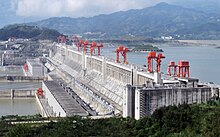
| Electricity generation installed capacity | 1,211 GW (2020)[1] |
| Electricity generation installed capacity compound annual growth rate | 2.7% (2011-2020)[1] |
| Share of world electricity generation | 16% (2018)[2] |
| Primary technology | Dam |
Since water is about 800 times denser than air, even a slow flowing stream of water, or moderate sea swell, can yield considerable amounts of energy. There are many forms of water energy:
- Historically, hydroelectric power came from constructing large hydroelectric dams and reservoirs, which are still popular in developing countries.[3] The largest of them are the Three Gorges Dam (2003) in China and the Itaipu Dam (1984) built by Brazil and Paraguay.
- Small hydro systems are hydroelectric power installations that typically produce up to 50 MW of power. They are often used on small rivers or as a low-impact development on larger rivers. China is the largest producer of hydroelectricity in the world and has more than 45,000 small hydro installations.[4]
- Run-of-the-river hydroelectricity plants derive energy from rivers without the creation of a large reservoir. The water is typically conveyed along the side of the river valley (using channels, pipes and/or tunnels) until it is high above the valley floor, whereupon it can be allowed to fall through a penstock to drive a turbine. This style of generation may still produce a large amount of electricity, such as the Chief Joseph Dam on the Columbia River in the United States.[5] Many run-of-the-river hydro power plants are micro hydro or pico hydro plants.
Hydropower is produced in 150 countries, with the Asia-Pacific region generating 32 percent of global hydropower in 2010. For countries having the largest percentage of electricity from renewables, the top 50 are primarily hydroelectric. China is the largest hydroelectricity producer, with 721 terawatt-hours of production in 2010, representing around 17 percent of domestic electricity use. There are now three hydroelectricity stations larger than 10 GW: the Three Gorges Dam in China, Itaipu Dam across the Brazil/Paraguay border, and Guri Dam in Venezuela.[6]
Wave power, which captures the energy of ocean surface waves, and tidal power, converting the energy of tides, are two forms of hydropower with future potential; however, they are not yet widely employed commercially. A demonstration project operated by the Ocean Renewable Power Company on the coast of Maine, and connected to the grid, harnesses tidal power from the Bay of Fundy, location of the world's highest tidal flow. Ocean thermal energy conversion, which uses the temperature difference between cooler deep and warmer surface waters, currently has no economic feasibility.[7][8]
Wind power
| Electricity generation installed capacity | 733 GW (2020)[9] |
| Electricity generation installed capacity compound annual growth rate | 14% (2011-2020)[9] |
| Share of world electricity generation | 5% (2018)[2] |
| Primary technology | Wind turbine |
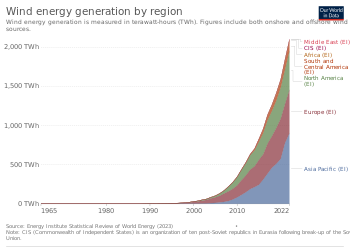

Air flow can be used to run wind turbines. Modern utility-scale wind turbines range from around 600 kW to 9 MW of rated power. The power available from the wind is a function of the cube of the wind speed, so as wind speed increases, power output increases up to the maximum output for the particular turbine.[12] Areas where winds are stronger and more constant, such as offshore and high-altitude sites, are preferred locations for wind farms. Typically, full load hours of wind turbines vary between 16 and 57 percent annually but might be higher in particularly favorable offshore sites.[13]
Wind-generated electricity met nearly 4% of global electricity demand in 2015, with nearly 63 GW of new wind power capacity installed. Wind energy was the leading source of new capacity in Europe, the US and Canada, and the second largest in China. In Denmark, wind energy met more than 40% of its electricity demand while Ireland, Portugal and Spain each met nearly 20%.[citation needed]
Globally, the long-term technical potential of wind energy is believed to be five times total current global energy production, or 40 times current electricity demand, assuming all practical barriers needed were overcome. This would require wind turbines to be installed over large areas, particularly in areas of higher wind resources, such as offshore. As offshore wind speeds average ~90% greater than that of land, so offshore resources can contribute substantially more energy than land-stationed turbines.[14]
Solar energy
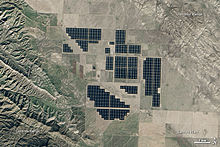
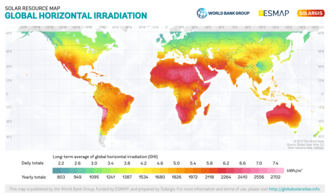
| Electricity generation installed capacity | 714 GW (2020)[16] |
| Electricity generation installed capacity compound annual growth rate | 29% (2011-2020)[16] |
| Share of world electricity generation | 2% (2018)[2] |
| Primary technologies | Photovoltaics, concentrated solar power, solar thermal collector |
Solar energy, radiant light and heat from the sun, is harnessed using a range of ever-evolving technologies such as solar heating, photovoltaics, concentrated solar power (CSP), concentrator photovoltaics (CPV), solar architecture and artificial photosynthesis.[17][18] Solar technologies are broadly characterized as either passive solar or active solar depending on the way they capture, convert, and distribute solar energy. Passive solar techniques include orienting a building to the Sun, selecting materials with favorable thermal mass or light dispersing properties, and designing spaces that naturally circulate air. Active solar technologies encompass solar thermal energy, using solar collectors for heating, and solar power, converting sunlight into electricity either directly using photovoltaics (PV), or indirectly using concentrated solar power (CSP).
A photovoltaic system converts light into electrical direct current (DC) by taking advantage of the photoelectric effect.[19] Solar PV has turned into a multi-billion, fast-growing industry, continues to improve its cost-effectiveness, and has the most potential of any renewable technologies together with CSP.[20][21] Concentrated solar power (CSP) systems use lenses or mirrors and tracking systems to focus a large area of sunlight into a small beam. Commercial concentrated solar power plants were first developed in the 1980s. CSP-Stirling has by far the highest efficiency among all solar energy technologies.
In 2011, the International Energy Agency said that "the development of affordable, inexhaustible and clean solar energy technologies will have huge longer-term benefits. It will increase countries' energy security through reliance on an indigenous, inexhaustible and mostly import-independent resource, enhance sustainability, reduce pollution, lower the costs of mitigating climate change, and keep fossil fuel prices lower than otherwise. These advantages are global. Hence the additional costs of the incentives for early deployment should be considered learning investments; they must be wisely spent and need to be widely shared".[17] Australia has the largest proportion of solar electricity in the world; in 2020, solar supplied 9.9% of electricity demand. [22]
Geothermal energy
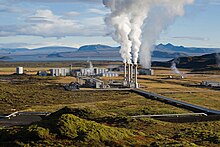
| Electricity generation installed capacity | 14 GW (2020)[23] |
| Electricity generation installed capacity compound annual growth rate | 3.7% (2011-2020)[23] |
| Share of world electricity generation | <1% (2018)[2] |
| Primary technologies | Dry steam, flash steam, and binary cycle power stations |
High temperature geothermal energy is from thermal energy generated and stored in the Earth. Thermal energy is the energy that determines the temperature of matter. Earth's geothermal energy originates from the original formation of the planet and from radioactive decay of minerals (in currently uncertain[24] but possibly roughly equal[25] proportions). The geothermal gradient, which is the difference in temperature between the core of the planet and its surface, drives a continuous conduction of thermal energy in the form of heat from the core to the surface. The adjective geothermal originates from the Greek roots geo, meaning earth, and thermos, meaning heat.
The heat that is used for geothermal energy can be from deep within the Earth, all the way down to Earth's core – 4,000 miles (6,400 km) down. At the core, temperatures may reach over 9,000 °F (5,000 °C). Heat conducts from the core to the surrounding rock. Extremely high temperature and pressure cause some rock to melt, which is commonly known as magma. Magma convects upward since it is lighter than the solid rock. This magma then heats rock and water in the crust, sometimes up to 700 °F (371 °C).[26]
Low temperature geothermal[27] refers to the use of the outer crust of the Earth as a thermal battery to facilitate renewable thermal energy for heating and cooling buildings, and other refrigeration and industrial uses. In this form of geothermal, a geothermal heat pump and ground-coupled heat exchanger are used together to move heat energy into the Earth (for cooling) and out of the Earth (for heating) on a varying seasonal basis. Low-temperature geothermal (generally referred to as "GHP") is an increasingly important renewable technology because it both reduces total annual energy loads associated with heating and cooling, and it also flattens the electric demand curve eliminating the extreme summer and winter peak electric supply requirements. Thus low temperature geothermal/GHP is becoming an increasing national priority with multiple tax credit support[28] and focus as part of the ongoing movement toward net zero energy.[29]
Bioenergy
| Electricity generation installed capacity | 127 GW (2020)[30] |
| Electricity generation installed capacity compound annual growth rate | 6.5% (2011-2020)[30] |
| Share of world electricity generation | 2% (2018)[2] |
| Primary technologies | Biomass, biofuel |
Biomass is biological material derived from living, or recently living organisms. It most often refers to plants or plant-derived materials which are specifically called lignocellulosic biomass.[31] As an energy source, biomass can either be used directly via combustion to produce heat, or indirectly after converting it to various forms of biofuel. Conversion of biomass to biofuel can be achieved by different methods which are broadly classified into: thermal, chemical, and biochemical methods. Wood remains the largest biomass energy source today;[32] examples include forest residues – such as dead trees, branches and tree stumps –, yard clippings, wood chips and even municipal solid waste. In the second sense, biomass includes plant or animal matter that can be converted into fibers or other industrial chemicals, including biofuels. Industrial biomass can be grown from numerous types of plants, including miscanthus, switchgrass, hemp, corn, poplar, willow, sorghum, sugarcane, bamboo,[33] and a variety of tree species, ranging from eucalyptus to oil palm (palm oil).
Plant energy is produced by crops specifically grown for use as fuel that offer high biomass output per hectare with low input energy.[34] The grain can be used for liquid transportation fuels while the straw can be burned to produce heat or electricity. Plant biomass can also be degraded from cellulose to glucose through a series of chemical treatments, and the resulting sugar can then be used as a first-generation biofuel.
Biomass can be converted to other usable forms of energy such as methane gas[35] or transportation fuels such as ethanol and biodiesel. Rotting garbage, and agricultural and human waste, all release methane gas – also called landfill gas or biogas. Crops, such as corn and sugarcane, can be fermented to produce the transportation fuel, ethanol. Biodiesel, another transportation fuel, can be produced from left-over food products such as vegetable oils and animal fats.[36] Also, biomass to liquids (BTLs) and cellulosic ethanol are still under research.[37][38] There is a great deal of research involving algal fuel or algae-derived biomass due to the fact that it is a non-food resource and can be produced at rates 5 to 10 times those of other types of land-based agriculture, such as corn and soy. Once harvested, it can be fermented to produce biofuels such as ethanol, butanol, and methane, as well as biodiesel and hydrogen. The biomass used for electricity generation varies by region. Forest by-products, such as wood residues, are common in the United States. Agricultural waste is common in Mauritius (sugar cane residue) and Southeast Asia (rice husks). Animal husbandry residues, such as poultry litter, are common in the United Kingdom.[39]
Biofuels include a wide range of fuels which are derived from biomass. The term covers solid, liquid, and gaseous fuels.[40] Liquid biofuels include bioalcohols, such as bioethanol, and oils, such as biodiesel. Gaseous biofuels include biogas, landfill gas and synthetic gas. Bioethanol is an alcohol made by fermenting the sugar components of plant materials and it is made mostly from sugar and starch crops. These include maize, sugarcane and, more recently, sweet sorghum. The latter crop is particularly suitable for growing in dryland conditions, and is being investigated by International Crops Research Institute for the Semi-Arid Tropics for its potential to provide fuel, along with food and animal feed, in arid parts of Asia and Africa.[41]
With advanced technology being developed, cellulosic biomass, such as trees and grasses, are also used as feedstocks for ethanol production. Ethanol can be used as a fuel for vehicles in its pure form, but it is usually used as a gasoline additive to increase octane and improve vehicle emissions. Bioethanol is widely used in the United States and in Brazil. The energy costs for producing bio-ethanol are almost equal to, the energy yields from bio-ethanol. However, according to the European Environment Agency, biofuels do not address global warming concerns.[42] Biodiesel is made from vegetable oils, animal fats or recycled greases. It can be used as a fuel for vehicles in its pure form, or more commonly as a diesel additive to reduce levels of particulates, carbon monoxide, and hydrocarbons from diesel-powered vehicles. Biodiesel is produced from oils or fats using transesterification and is the most common biofuel in Europe. Biofuels provided 2.7% of the world's transport fuel in 2010.[43]
Biomass, biogas and biofuels are burned to produce heat/power and in doing so harm the environment. Pollutants such as sulphurous oxides (SOx), nitrous oxides (NOx), and particulate matter (PM) are produced from the combustion of biomass; the World Health Organisation estimates that 7 million premature deaths are caused each year by air pollution.[44] Biomass combustion is a major contributor.[44][45][46] [failed verification]
Notes
- ^ a b IRENA 2021, p. 8.
- ^ a b c d e "Electricity". International Energy Agency. 2020. Data Browser section, Electricity Generation by Source indicator. Retrieved 17 July 2021.
- ^ Moran, Emilio F.; Lopez, Maria Claudia; Moore, Nathan; Müller, Norbert; Hyndman, David W. (2018). "Sustainable hydropower in the 21st century". Proceedings of the National Academy of Sciences. 115 (47): 11891–11898. doi:10.1073/pnas.1809426115. ISSN 0027-8424. PMC 6255148. PMID 30397145.
- ^ "DocHdl2OnPN-PRINTRDY-01tmpTarget" (PDF). Archived from the original (PDF) on 9 November 2018. Retrieved 26 March 2019.
- ^ Afework, Bethel (3 September 2018). "Run-of-the-river hydroelectricity". Energy Education. Retrieved 27 April 2019.
- ^ Institute, Worldwatch (January 2012). "Use and Capacity of Global Hydropower Increases". Archived from the original on 24 September 2014. Retrieved 18 January 2014.
- ^ "How Does Ocean Wave Power Work?". Energy Informative. Retrieved 27 April 2019.
- ^ Unwin, Jack (12 March 2019). "Top five trends in wave power". Retrieved 27 April 2019.
- ^ a b IRENA 2021, p. 13.
- ^ "Wind energy generation by region". Our World in Data. Retrieved 5 March 2020.
- ^ "Global Wind Atlas".
- ^ "Analysis of Wind Energy in the EU-25" (PDF). European Wind Energy Association. Retrieved 11 March 2007.
- ^ Martin Kaltschmitt, Wolfgang Streicher, Andreas Wiese (eds.): Erneuerbare Energien. Systemtechnik, Wirtschaftlichkeit, Umweltaspekte. Springer, Berlin/Heidelberg 2013, p. 819.
- ^ "Offshore stations experience mean wind speeds at 80 m that are 90% greater than over land on average." Evaluation of global wind power "Overall, the researchers calculated winds at 80 meters [300 feet] above sea level traveled over the ocean at approximately 8.6 meters per second and at nearly 4.5 meters per second over land [20 and 10 miles per hour, respectively]." Global Wind Map Shows Best Wind Farm Locations Archived 24 May 2005 at the Wayback Machine. Retrieved 30 January 2006.
- ^ "Global Solar Atlas".
- ^ a b IRENA 2021, p. 20.
- ^ a b Solar energy perspectives. Philibert, Cédric., International Energy Agency., Organisation for Economic Co-operation and Development. Paris: OECD/IEA. 2011. ISBN 978-92-64-12458-5. OCLC 778434303.
{{cite book}}: CS1 maint: others (link) - ^ "Solar Fuels and Artificial Photosynthesis". Royal Society of Chemistry. 2012. Retrieved 11 March 2013.
- ^ "Energy Sources: Solar". Department of Energy. Retrieved 19 April 2011.
- ^ NREL.gov U.S. Renewable Energy Technical Potentials: A GIS-Based Analysis, July 2013 : iv
- ^ thinkprogress.org National Renewable Energy Laboratory: Solar Has The Most Potential Of Any Renewable Energy Source Archived 22 January 2015 at the Wayback Machine, 30 July 2013
- ^ Clean Energy Council Australia. "Clean Energy Australia Report 2021" (PDF). Clean Energy Australia. Retrieved 2 April 2021.
- ^ a b IRENA 2021, p. 38.
- ^ Dye, S. T. (2012). "Geoneutrinos and the radioactive power of the Earth". Reviews of Geophysics. 50 (3): 3. arXiv:1111.6099. Bibcode:2012RvGeo..50.3007D. doi:10.1029/2012rg000400. S2CID 118667366.
- ^ Gando, A.; Dwyer, D. A.; McKeown, R. D.; Zhang, C. (2011). "Partial radiogenic heat model for Earth revealed by geoneutrino measurements" (PDF). Nature Geoscience. 4 (9): 647–651. Bibcode:2011NatGe...4..647K. doi:10.1038/ngeo1205.
- ^ Nemzer, J. "Geothermal heating and cooling". Archived from the original on 11 January 1998.
- ^ Cite error: The named reference
energy.govwas invoked but never defined (see the help page). - ^ "Database of State Incentives for Renewables & Efficiency® - DSIRE". DSIRE.
- ^ Cite error: The named reference
Net Zero Foundationwas invoked but never defined (see the help page). - ^ a b IRENA 2021, p. 27.
- ^ Biomass Energy Center. Biomassenergycentre.org.uk. Retrieved on 28 February 2012.
- ^ "Log In". online.wsj.com.
- ^ "Developing a Willow Biomass Crop Enterprise for Bioenergy and Bioproducts in the United States". North East Regional Biomass Program. January 2000. Retrieved 4 June 2015.
{{cite web}}: Unknown parameter|authors=ignored (help) - ^ "Energy crops". crops are grown specifically for use as fuel. BIOMASS Energy Centre. Archived from the original on 10 March 2013. Retrieved 6 April 2013.
- ^ Howard, Brian (28 January 2020). "Turning cow waste into clean power on a national scale". TheHill. Retrieved 30 January 2020.
- ^ Energy Kids. Eia.doe.gov. Retrieved on 28 February 2012.
- ^ "Fuel Ethanol Production: GSP Systems Biology Research". U.S. Department of Energy Office of Science. 19 April 2010. Archived from the original on 27 May 2010. Retrieved 2 August 2010.
- ^ "Breaking the Biological Barriers to Cellulosic Ethanol: A Joint Research Agenda" (PDF). June 2006. Retrieved 2 August 2010.
- ^ Frauke Urban and Tom Mitchell 2011. Climate change, disasters and electricity generation Archived 20 September 2012 at the Wayback Machine. London: Overseas Development Institute and Institute of Development Studies
- ^ Demirbas, A. (2009). "Political, economic and environmental impacts of biofuels: A review". Applied Energy. 86: S108–S117. doi:10.1016/j.apenergy.2009.04.036.
- ^ Sweet sorghum for food, feed and fuel Archived 4 September 2015 at the Wayback Machine New Agriculturalist, January 2008.
- ^ "Opinion of the EEA Scientific Committee on Greenhouse Gas Accounting in Relation to Bioenergy". Retrieved 1 November 2012.
- ^ REN21 (2011). "Renewables 2011: Global Status Report" (PDF). pp. 13–14. Archived from the original (PDF) on 13 May 2012.
{{cite web}}: CS1 maint: numeric names: authors list (link) - ^ a b "WHO - 7 million premature deaths annually linked to air pollution".
- ^ "WHO - Ambient (outdoor) air quality and health". Archived from the original on 4 January 2016.
- ^ "WHO - Household air pollution and health". Who.int. Retrieved 26 March 2019.
References
Renewable Capacity Statistics 2021. Abu Dhabi: International Renewable Energy Agency (IRENA). March 2021. ISBN 978-92-9260-342-7. Retrieved 17 July 2021.


